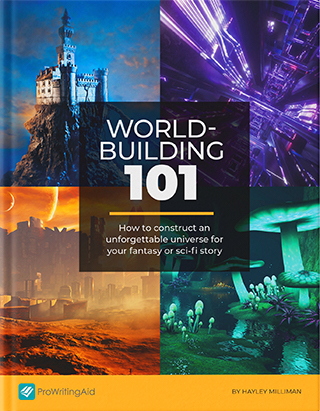
Someone did something somewhere.
That's every story at its most basic. The "somewhere" is setting, and it's our focus for today.
But "somewhere" isn't especially vivid, is it? Whether we're writing a real or fictional setting, we want it to feel detailed, interesting, and authentic. Here are six ways to do it.
1. Draw Inspiration from Real Life
This advice applies to most aspects of fiction, but I find it’s especially useful for setting.
For example, if you’re writing a story set in New York City, much of the creative work is already done, especially if you live or have lived there. Draw from that experience. Show readers what it’s like to walk down Broadway on a Saturday afternoon. Describe the Empire State building, Yankee Stadium, or Grand Central Station in as much detail as you can.
Fortunately, real life details can also help when writing a fictional setting. For example, let’s say you’re writing urban fantasy. You can still borrow aspects of New York City for your setting, even if your city doesn’t exist. It might be located on a river like the Hudson. It might have several distinct boroughs, like Queens, Manhattan, and the Bronx. Your city might even smell like New York (though I’ll admit that’s not always pleasant).
With any setting, recall the real places you’ve been to, then borrow details from them.
2. Do Your Research
What if you want to write about a place you’ve never been to? Romance writers might set a love story in Paris. Mystery writers might set a murder in a remote part of Canada. Fantasy writers might create an entirely alternate world, one which no one has ever visited. Is it still possible?
Of course! It's all about research.
Search for concrete details about your setting, such as landmarks, architecture, geology, interesting facts, relevant history, or anything else that piques your interest. Specific details can go a long way in bringing a setting to life.
If it’s a real place, read articles by residents of your setting. Find books set in those places; preferably non-fiction, but fiction can work, too.
If you’re writing an alternate world, map them onto real life. For example, George R.R. Martin's Westeros is heavily based on medieval Europe. Find your analogous setting, then draw details from it.
But research need not stop with the basics. There are more advanced options, too…
3. Get Techy
We writers today are lucky. There are many free or inexpensive tools at our disposal that can improve our settings, and top of my list is Google Street View.
If you’ve never used it before, this is a neat tool. It’s essentially a three-dimensional interactive image that covers most of the world. Enter an address to see what that place looks like. I’ve never been to Shanghai, but let’s say I wanted to write a short story there. I might use Street View to see what it’s like to walk the streets of the city.

I can get so many great details from this simple tool. I can see what the architecture looks like. I can see how many people are on the street. I can see how many cars are on the road, and their general appearance. I can see which streets intersect with each other, and how far it is to the highway. I can even see what sort of advertisements they have up! This is all gold for your setting.
4. Engage Your Senses
Street view is excellent for visuals, but don’t forget your other senses. The best settings don’t just have a distinct look. You want readers to imagine how your settings sound, smell, feel, and maybe even taste.
Of course, this goes back to the issue of writing settings that either don’t exist, or those you’ve never been to. If this is the case, draw sensory details from places you have visited. Draw from your sight, yes, but recall what you heard, smelled, tasted, and touched while you were there. Sometimes writers focus too hard on visuals, so it’s important to keep these other senses in mind.
5. Treat Your Setting Like a Character
This is an exercise I love. Since people connect with people, treating your setting like a character might make it feel more authentic. There are many ways to do this. Consider conflict, for example. Great characters have great conflicts, so why can’t a setting do the same?
N.K. Jemisin’s The Fifth Season takes setting conflict to a whole new level. In this book, the world is out to get people, somewhat literally. Cataclysms and natural disasters are commonplace, so it’s up to people with special powers to control it.
This is a literal example, but it works. Giving a setting a conflict can make it feel more authentic. Alternatively, you could give your setting a detailed backstory like J.R.R. Tolkien did in his Lord of the Rings trilogy. Like a layered character, Middle-Earth has backstory – thousands of years’ worth, in fact.
Think of your setting like a character. It could help make it more vivid.
6. Don't Spend Too Long Describing
I know I've just been telling you how to describe your setting, but hear me out. You can create an immersive and vivid setting by giving your readers the occasional detail that has an impact on your plot. This will help immerse your readers and enrich your story. But if you establish your setting in long descriptive sections, they might start to nod off.
You can use ProWritingAid's pacing check to see where you might be spending too long on description. Try breaking up these sections with some action or spreading the details out throughout your story.
Make Your Setting Shine
I hope these tips will help take your setting from "somewhere" to something unique. Try them out and see what you think!



